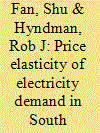| Srl | Item |
| 1 |
ID:
123497


|
|
|
|
|
| Publication |
2013.
|
| Summary/Abstract |
Howitt () claims that state control over mineral and energy resources and developer-Indigenous relations constitute the 'active erasure' of Indigenous knowledge and governance. The cultures and interests of Indigenous players are diverse and at times conflicting during Indigenous-mining interface, and collective bargaining has been shown to substantially weaken these positions, especially in regard to those Indigenous players primarily concerned with the protection of localised heritage. This paper explores a case study from a remote region of South Australia to document this erasure and its implications and to advocate decolonisation of the regulatory interfaces between mining and Indigenous peoples in resource, environmental and heritage governance. It adopts an Indigenous standpoint for research and argues the need for academic research to accept responsibility for some weaknesses in existing systems. The experiences of Adnyamathanha people are used to support an argument that Indigenous empowerment through informed decision-making and a decolonising engagement strategy are yet to be fully realised as key components of an effective interface between Indigenous and commercial players.
|
|
|
|
|
|
|
|
|
|
|
|
|
|
|
|
| 2 |
ID:
175928


|
|
|
|
|
| Summary/Abstract |
In the 14 years from 2004 to 2018, the state of South Australia underwent a sustainability transition that saw its privately owned and operated electricity system change from 100% fossil fuel generation to a position where 50% was generated by wind and solar. However, this transition has not been without controversy. Most notably, in 2016 and again in 2017, the state was hit with major blackouts that many powerful individuals and organisations blamed on the renewables transition. The result of these blackouts and the substantial political fallout from them was the formulation and release of a new energy policy in 2017. Via a series of interviews with actors directly involved with the formulation of this new policy and an analysis of other sources attached to the state’s renewables transition, this article reflects upon the elements and motivations that made and continue to make the renewables transition in South Australia successful. In particular, the research shows that when renewables establish a critical mass of generation, they produce a path dependent trajectory that is difficult to alter. In conclusion, the experience of South Australia demonstrates a means by which renewables transitions can be expedited by public policy initiatives in a privatised market system.
|
|
|
|
|
|
|
|
|
|
|
|
|
|
|
|
| 3 |
ID:
112853


|
|
|
|
|
| Publication |
2012.
|
| Summary/Abstract |
In late eighteenth-century Edo there was a tradition of popularising elite culture. Two artistic forms that were changed by this desire to innovate were theukiyo-eprint and music for thekoto(13-string zither). Theukiyo-eprint was developed from single colours into a full colour extravaganza (nishiki-e) by the need for patrons and artists to compete with each other in a growing market whilekotosong cycles, known askumi-uta, became standardised in written notation and captured an oral tradition that was disappearing with the death of its practitioners. As a result, thenishiki-etook classical subject matter to the masses through the use ofmitate-eor parody and the publication ofkumi-utasongbooks presented any performer with song melodies and lyrics for every occasion, turning classical performance and themes into popular music. This article analyses Harunobu's two versions of the print ofDescending Geese of the Koto Bridges - a rare copy found in the Art Gallery of South Australia and the other held in the Museum of Fine Arts, Boston - to reveal the way in which popularisation created synergy between the full-colourukiyo-eprint and self-accompanied singing with thekoto.
|
|
|
|
|
|
|
|
|
|
|
|
|
|
|
|
| 4 |
ID:
105790


|
|
|
|
|
| Publication |
2011.
|
| Summary/Abstract |
In this paper, the price elasticity of electricity demand, representing the sensitivity of customer demand to the price of electricity, has been estimated for South Australia. We first undertake a review of the scholarly literature regarding electricity price elasticity for different regions and systems. Then we perform an empirical evaluation of the historic South Australian price elasticity, focussing on the relationship between price and demand quantiles at each half-hour of the day.
This work attempts to determine whether there is any variation in price sensitivity with the time of day or quantile, and to estimate the form of any relationships that might exist in South Australia.
|
|
|
|
|
|
|
|
|
|
|
|
|
|
|
|